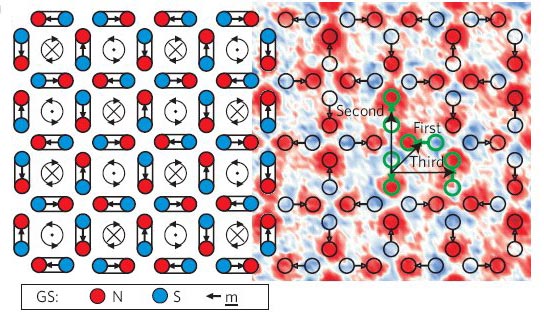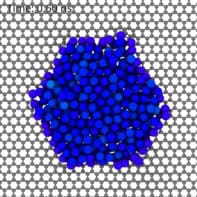
Physicists in the UK and the US are the first to encourage artificial spin ices – magnetic nano-structures analogous to water ice – into a square formation that is very close to the ground state. The discovery could help researchers to develop “bit pattern” data storage, where sheets of magnetic material are replaced by arrays of magnetic islands.
In spin ices, the interactions between atoms are “frustrated” so they cannot settle into a crystalline state where all interaction energies are minimized. Water ice is an example of such a frustrated structure. To form a perfect crystal, the hydrogen atoms would have to be located halfway between the oxygen atoms. However, each oxygen atom prefers to hold on closely to two hydrogens through short-range covalent bonds.
In fact, the solid only works when every oxygen is covalently bonded to two hydrogen atoms – those identified in the “H20″ – and two at a distance through long-distance hydrogen bonds. The result is a solid with a disordered distribution of short and long bonds between oxygen and hydrogen.
Artificial spin ices consist of analogous “atoms” made of tiny magnets, each a dipole that tries to align with its neighbours to satisfy interactions. They present a way to understand the frustrated structure of water because, unlike water, their interactions occur on a large enough scale to be studied through a microscope. Artificial spin ices could also be studied to figure out how to pack together magnetic dipoles for data storage, without letting interactions spoil the dipoles’ alignment.
Spin ice jam
Yet one of the troubles in working with artificial spin ices has been how to get them into a ground state, where the dipoles exhibit long-range order. Like coarse sand in a funnel, the dipoles tend to jam in a high-energy state during fabrication. In the past, researchers have tried applying rotating magnetic fields to encourage the dipoles into lower energy states – the equivalent of shaking up the sand – but this has not proved totally successful. “You get them into some low energy state, but not into the ground state, or anywhere close,” says Christopher Marrows of the University of Leeds.
Marrows’ group, which includes colleagues at Rutherford Appleton Laboratory in Oxfordshire and Brookhaven National Laboratory in the US, has now identified a square artificial spin ice in what seems to be the ground state – or very close to it. In their experiment, Marrows and colleagues placed a stencil on top of a silicon wafer and used an electron beam to deposit a nickel-iron alloy. When they removed the stencil, they were left with a square array of magnetic domains – the artificial spin ice.
Marrows’ group then used a technique called magnetic force microscopy to image the sample, and discovered that, unusually, it displayed the long-range order typical of a ground state. According to Marrows, the order probably arose because of thermal agitations that could shake the diploes towards the ground state while the spin ice was still thin. In the normal fabrication of artificial spin ices, he says, this can’t happen because a thick layer of magnetic alloy is etched away to form dipoles – there is no thin stage.
Square versus triangles
Oleg Tchernyshyov, an expert in spin ices at Johns Hopkins University in Baltimore, US, believes the development is not totally new, since other researchers have achieved ground-state ordering in spin ices with “kagome” (interlaced triangular) arrays of dipoles, as opposed to square arrays. Tchernyshyov adds, however: “To Marrows’ credit, it is much harder to get rid of defects in square ice than in its kagome counterpart.”
Marrows told physicsworld.com he next wants to investigate what happens with artificial spin ices on smaller scales, which might be able to show how thermal agitations shift the dipoles around. “Because you’ve built it using nanotechnology you can control everything,” he says. “You can tune the strength of all the interactions at will, just by making a slightly different pattern – a little bigger, or a little smaller. You can’t do that with the natural systems.”
The research is published in Nature Physics.



